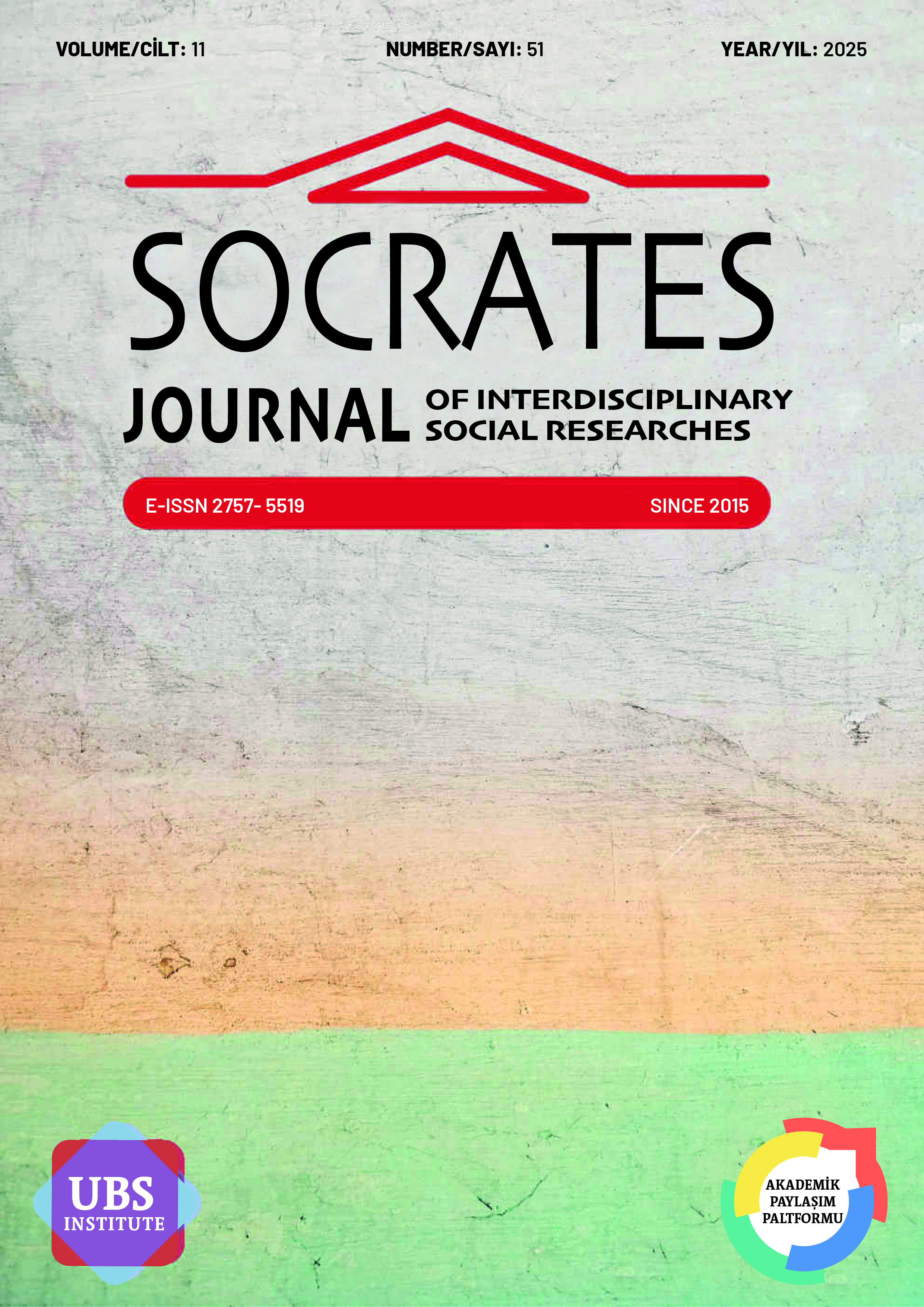“ÖTEKİ BEDEN”DE SİBERFEMİNİST YANSIMALAR
CYBERFEMINIST REFLECTIONS IN THE “OTHER BODY”
DOI:
https://doi.org/10.5281/zenodo.15034097Anahtar Kelimeler:
Siberfeminizm, öteki beden, çağdaş sanat, dijital teknoloji, kimlikÖzet
Siberfeminizm, dijital teknolojilerin toplumsal cinsiyet, kimlik ve beden anlayışları üzerindeki etkilerini ele alan bir kavram olarak, postmodern düşüncenin bir uzantısıdır. 1980’lerin ortasında Donna Haraway tarafından yazılan “Siborg Manifestosu” ile temelleri atılan siberfeminizm, biyolojik sınırları aşan, teknolojiyle harmanlanmış kimlikler ve bedenler fikrini tartışmaya açmıştır. Bu bağlamda siberfeminizm, bedeni yalnızca biyolojik bir yapı olmaktan çıkarıp dijitalleşen, değişen ve dönüşen bir veri alanı olarak incelemektedir. Dolayısıyla "öteki beden," normatif biyolojik ya da kültürel yapılar dışında kalan, dışlanan ya da yeniden tanımlanan bedenleri ifade etmektedir. Dolayısıyla araştırmada siberfeminizm çerçevesinde "öteki beden" kavramının çağdaş sanattaki yansımalarını incelemek amaçlanmıştır. Bu bağlamda dört önemli sanatçının araştırmaya konu olan sanat üretimleri örneğinde, “öteki beden”in çağdaş sanattaki temsil biçimleri ve siberfeminizmin bu temsillerdeki rolü ele alınmıştır. Heather Dewey-Hagborg’un “Xeno in Vevo”, Tabita Rezaire’in “Deep Down Tidal”, Sondra Perry’nin “Graft and Ash for a Three Monitor Workstation” ve Claudia Hart’ın “Body on Screen” isimli üretimleri, dijital teknolojilerin çağdaş sanattaki yansımaları ve “öteki beden”in temsiline dair önemli örnekler sunmaktadır. Bu dört sanatçının üretimleri üzerinden görsel analiz ve teorik çerçeve kullanılarak siberfeminizmin “öteki beden” anlayışı analiz edilecektir. Siberfeminizmin çağdaş sanatta “öteki beden” kavramına olan etkileri araştırmanın ana konusunu oluşturmaktadır. Sanatın toplumsal normları ve kimlik yapılarını nasıl sorgulayıp dönüştürdüğüne odaklanılarak, dijital teknolojilerin toplumsal yapıları dönüştürme potansiyeline sahip olduğu vurgulanacaktır. Araştırma çağdaş sanatın ve siberfeminizmin kesişim noktasındaki güçlü etkilerinin ortaya konması bağlamında önem taşımaktadır. Sonuç olarak bu araştırma, çağdaş sanatın “öteki beden”in temsili ile dijital teknolojiler arasındaki ilişkilerini inceleyerek, siberfeminizmin beden politikalarına dair nasıl eleştirel bir bakış açısı sunduğunu ortaya koymuştur. Araştırmada ele alınan üretim örnekleri, dijital teknolojiler ve siberfeminist yaklaşımlar aracılığıyla, toplumsal normların nasıl sorgulandığını ve toplumsal cinsiyet, kimlik ve beden kavramlarının nasıl yeniden inşa edildiğini göstermektedir. Dolayısıyla bu araştırma, sanat ve teknolojinin kesişimini toplumsal yapıları yeniden hayal etmek için güçlü bir alan olarak vurgularken, siberfeminizmin beden politikalarına dair eleştirel rolüne dikkat çekmektedir.
Referanslar
Antmen, A. (2021). Sanatçılardan yazılar ve açıklamalarla 20. yüzyıl batı sanatında akımlar (11. Baskı b.). (A. Antmen, Dü., & A. Antmen, Çev.). Sel Yayıncılık.
Aydemir, D. (2020). Siberfeminizm ve siber kültürde cinsiyet kimliğinin yapıbozumu ve siber kimlikle yeniden inşası [Yüksek lisans tezi]. Ondokuz Mayıs Üniversitesi.
Balıkçı, N. (2023). 1990'dan Günümüze siberfeminist yaklaşımlarda kadın ve doğa. [Yüksek lisans tezi]. Dokuz Eylül Üniversitesi.
Butler, J. (2020). Cinsiyet belası feminizm ve kimliğin altüst edilmesi (8. Baskı). (Özde, Ö. D. Gürkan, Dü, & B. Ertür, Çev.). Metis Yayınları.
Dewey-Hagborg, H. (t.y.). Heather dewey-hagborg-xeno in vivo. Heather dewey-hagborg: https://deweyhagborg.com/projects/xeno-in-vivo, 07.12.2024.
Dursun, A. N. (2020). Toplumsal cinsiyet eşitsizliğine bir çözüm olarak siberfeminizm. [Yüksek lisans tezi]. Kütahya Dumlupınar Üniversitesi.
Gerçek Kutlu, D. (2019). Siberfeminizmde Grotesk, Abjection ve Informel Kavramları Üzerine Bir İnceleme [Yüksek lisans tezi]. Erciyer Üniversitesi.
Güncel Türkçe Sözlük. (t.y.). Türk Dil Kurumu Sözlükleri: https://sozluk.gov.tr/, 08.10.2024.
Haraway, D. (2006). Siborg manifestosu: Geç yirminci yüzyılda bilim, teknoloji ve sosyalist-feminizm. (S. Yurt, Dü., & O. Akınhay, Çev.) Agora Kitaplığı.
Haraway, D. (2010). Başka yer (1. b.). (G. Pusar, Çev.). Metis Yayınları.
Karakuyu Şengüder, M. (2019, Haziran 19). Sanatta görüntü üretiminin kültür endüstrisine etkisi. Sanat ve Tasarım Dergisi, 23, 281-299.
Korkmaz, B. (2024). Transhümanizm kavramı içerisinde değişen beden fikri ve sanatta yeri. Yüksek Lisans Sanat Çalışması Raporu, Hacettepe Üniversitesi.
Millett, K. (2018). Cinsel politika (4. b.). (F. Koçer, Dü., & S. Selvi, Çev.) Payel Yayınevi.
Nochlin, L. (2022). Neden hiç büyük kadın sanatçı yok? (F. Candil Erdoğan, Dü., & A. Ahu, Çev.). Hayalperest Yayınevi.
Odabaşı Yöney, D. (2020). Yeni medyada toplumsal cinsiyet eşitsizliği ve siber-feminizmin yıkılışı [Yüksek lisans tezi]. İstanbul Üniversitesi.
Öz, R. ve Askel Durmuş, H. S. (2023). Judith Butler’a göre kadının özneliği problemi. Erzurum Teknik Üniversitesi Sosyal Bilimler Enstitüsü Dergisi, 18, 128-139.
Saint-Louis, E.A., & Staff, C. (2018). The harward crimson-graft and ash for a three monitor workstation. The harward crimson: https://www.thecrimson.com/column/in-total-darkness/article/2018/4/5/intotaldarkness-graftandash/, 07.12.2024.
Weisburg, M. (t.y.). La Biennale di Venezia-Sondra Perry. La Biennale di Venezia: https://www.labiennale.org/en/art/2022/milk-dreams/sondra-perry, 07.12.2024.
İndir
Yayınlanmış
Nasıl Atıf Yapılır
Sayı
Bölüm
Lisans
Telif Hakkı (c) 2025 Socrates Journal of Interdisciplinary Social Researches

Bu çalışma Creative Commons Attribution 4.0 International License ile lisanslanmıştır.


